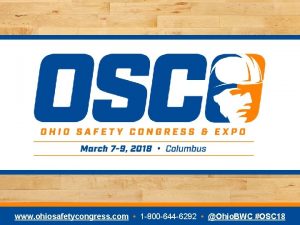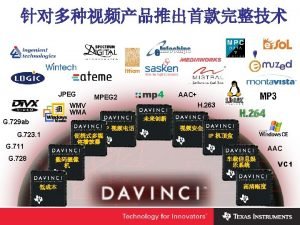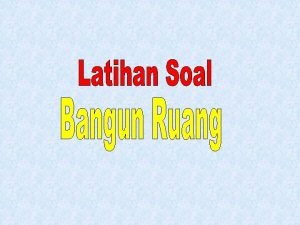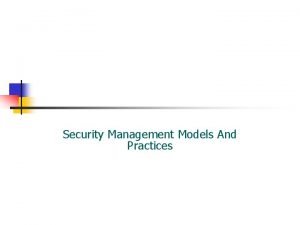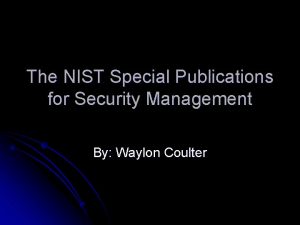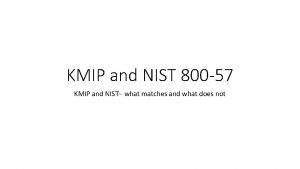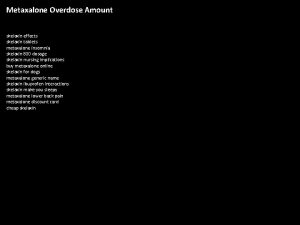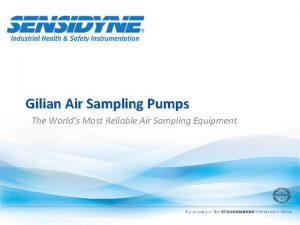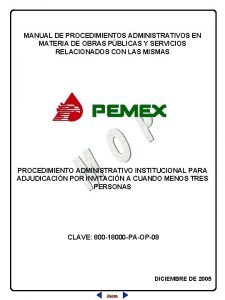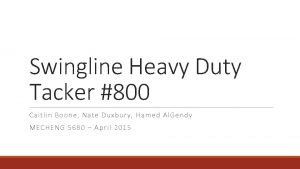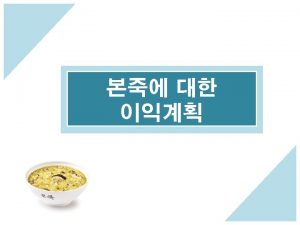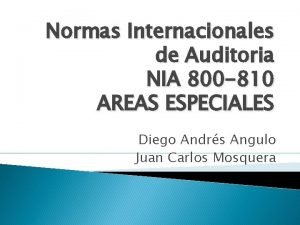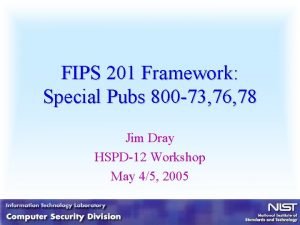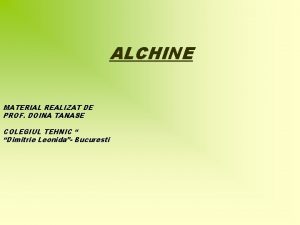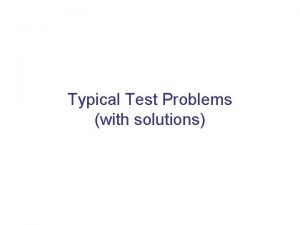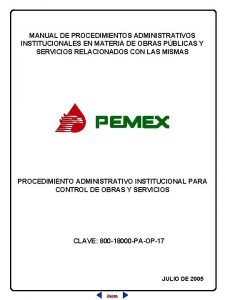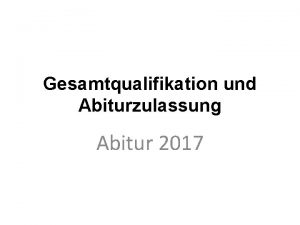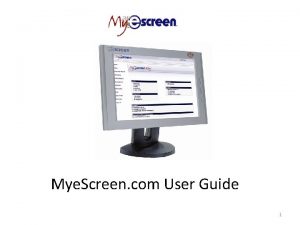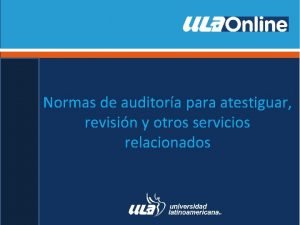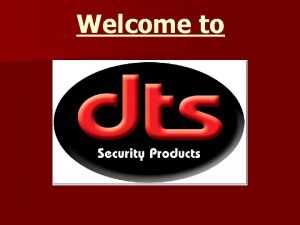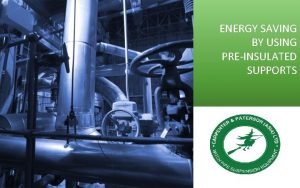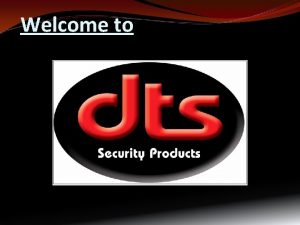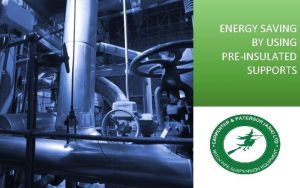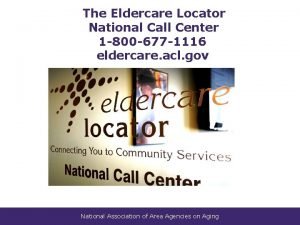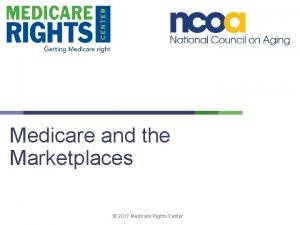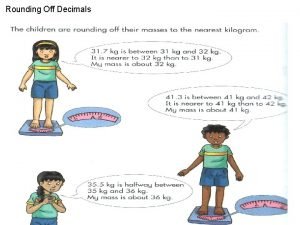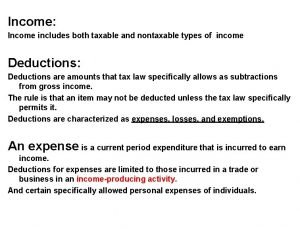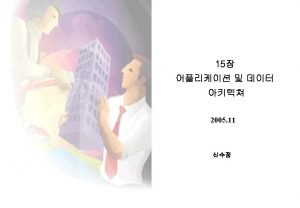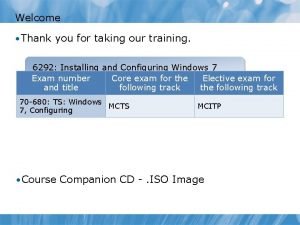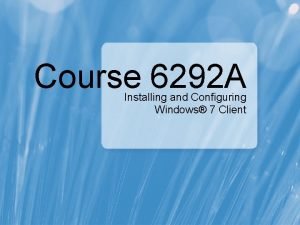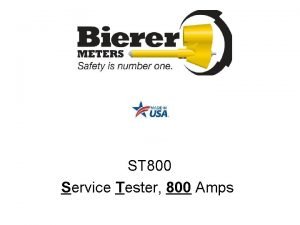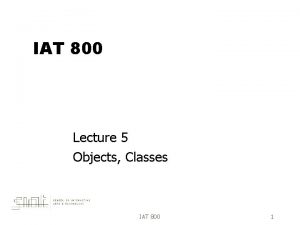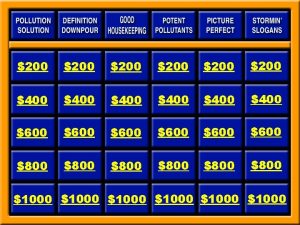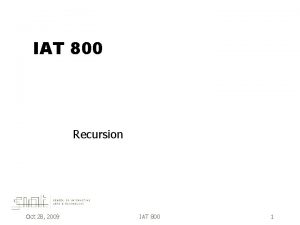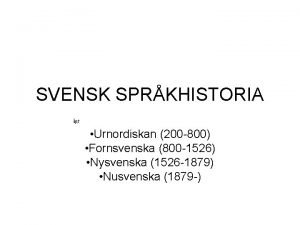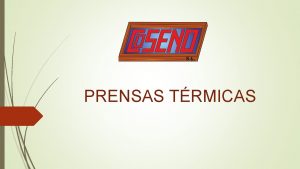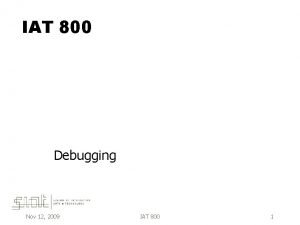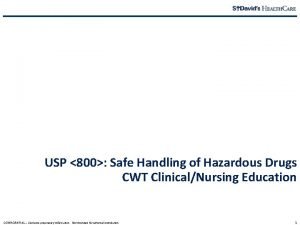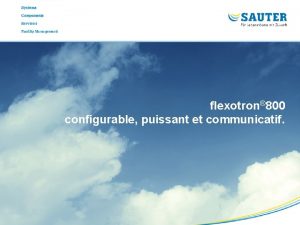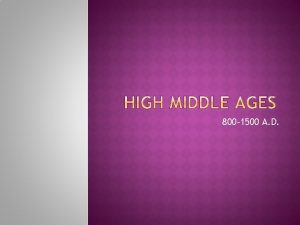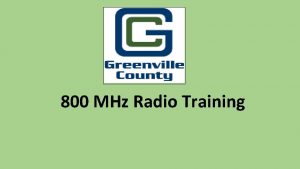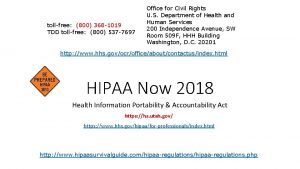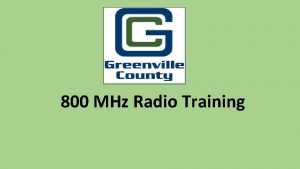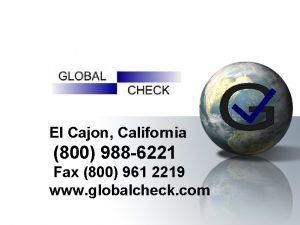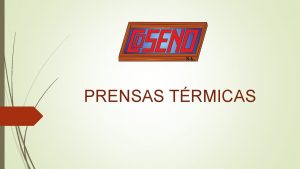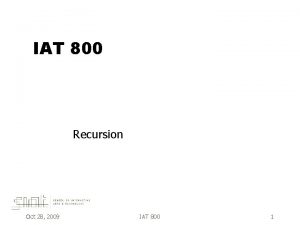www ohiosafetycongress com 1 800 644 6292 Ohio
















































- Slides: 48

www. ohiosafetycongress. com • 1 -800 -644 -6292 • @Ohio. BWC #OSC 18

Developing a Safety Culture Brian Zachetti, CSP Industrial Safety Consultant Specialist 330 -301 -1567 BWC Division of Safety and Hygiene

Traditional Safety Programs • Compliance with OSHA Regulations • Safety Inspections • Enforcement of Safety Rules (usually through disciplinary action)

Why traditional safety programs do not work: • Safety is a priority, not a value • Safety is not managed in the same manner as production, quality, and cost issues. • Safety is not driven through continuous improvement.

“Fallacies or realities” in safety fables? • • Conditions cause accidents. Enforcing rules improves safety. Safety professionals can keep workers safe. Low accident rates indicate safety programs are working well. • Investigating to find the root cause of accidents alone will improve safety. • Awareness training improves safety. • Rewards improve safety.

Traditional Safety Programs Safety training Policies Slogans Fewer accidents Reprimands Safety meetings Contests and awards Regulations Committees and councils

Proactive, Preventative Safety and Health Program • A culture that says “safety” is important around here. • A tight accountability system. (Supervisor/Employee Performance Measures) • Driven by the costs of injuries rather than fear of OSHA fines. • Focus on at risk behaviors rather than unsafe acts.

Safety Is About Culture • Therefore, compliance is necessary but not sufficient for great safety. • Safety is about people and behavior is the challenge.

Leadership • Leadership commitment to safety is active, visible, and lively. • A clear and inspiring vision has been established for safe performance. • Safety is viewed and treated as a line management responsibility. • Safety is clearly perceived as an organizational value on the same level with productivity and quality.

Systems and processes • Supervisors and workers partner to find and correct causes of system incidents. • Communication systems are abundant, effective and flow well in all directions. • Training systems deliberately and systematically create competency for the right people at the right time. • Safe operating procedures and policies are clearly defined and communicated.

Involvement • Workers are skilled at problem solving and decision making. • Labor and management work together to address safety systems issues. • Team orientation achieves involvement and cooperation. • Innovation, participation and suggestions are encouraged at all levels.

Organizational style • Trust and openness are the norm. • Positive reinforcement is used regularly. • Bureaucratic obstacles are removed. • There is formal and informal recognition for great performance at all levels.

Safety Is About Accountability • All levels of the organization have safety goals and process responsibilities are clearly defined. • The process of achieving results is a key safety measure. • Performance reviews include accountability for safe performance at all levels. • Supervision is accountable to perform safety observations and feedback.

Safety Is About The Costs Of Accidents

Claims Cost Example Medical Costs – $5, 000 TT Compensation - $10, 000 Reserves - $50, 000 Total Value - $65, 000 Value Without Reserves - $15, 000

Indirect Costs are 4 times each company’s Direct Costs Medical & Compensation Costs. . . …… $15, 000 Compensation Reserve. . . …… $50, 000 Total Insured Cost. . . …. … $65, 000 Total Insured (direct costs) X (indirect costs) factor = $65, 000. 00 X 4 times = $260, 000. 00 Total Insured (direct costs) + (indirect

How Many Widgets Is That? • 1 Widget Costs $800 • Average Profit Margin = 10% • That means if we get average profit all we earn is $80. 00/Widget • $325, 000/$80. 00 = 4, 062 Widgets /Year To Cover Costs Of Accidents/Injuries.

Work in a culture where the costs of accidents is understood • What new equipment can we have? • What bonuses or incentives can we get? • How much is our paycheck? • Can we get a raise? • How much harder do we have to work? • What promotion opportunities are available to us? • Do we still have a job?

How Do We Get There - You Have To Want It • A true long term commitment to change, instead of “just another program” • Requires visible and active senior management leadership

Assess The Current Culture You Have Determine The Culture You Want • Where are we right now? • Written perception surveys? • What old habits will need to be addressed? • How will tomorrow be different from today? • What will it look like? • Written safety and health policy

Get Middle Managers and First Line Supervisors on Board • Will make or break the change process • Might have to be forced at first

Get Middle Managers and First Line Supervisors on Board • “Supervisors are those persons between management and the workers who translate the organizations policy into action. The supervisor is the key in industrial accident prevention” Dan Petersen

Supervisor Responsibilities • • Enforce work methods and safe work practices Positive Reinforcement vs. Disciplinary Action Provide job instructions Supervise people at work (Don’t stand around and talk) • Providing proper training and coaching. • Conduct effective accident investigation • Adhering to high standards of safety.

Safety Is About Accountability

Unsafe Behaviors Vs. Conditions

Unsafe Acts Vs. Unsafe Conditions • Approximately 1 -5 percent of injuries occur because of hazardous or unsafe conditions. • Approximately 95 -99 percent of injuries are a result of at risk behaviors.

Unsafe Acts Vs Unsafe Conditions • OSHA Compliance - focuses on hazards and unsafe conditions • Therefore, while compliance is important, it does not create exceptional safety performance. • In 1976 - nine of every 100 workers were being injured on the job. • In 2016 - seven of every 100 workers are still being injured on the job.

Behavior based safety(BBS) is: • An excellent tool for collecting data on the quality of a company’s safety management system; • A scientific way to understand why people behave the way they do when it comes to safety; • Properly applied, an effective next step towards creating a truly pro-active safety culture where loss prevention is a core value; • Conceptually easy to understand but often hard to implement and sustain.

Behavior based safety is not: • Only about observation and feedback; • Concerned only about the behaviors of line employees; • A substitution for traditional risk management techniques; • About cheating and manipulating people and aversive control; • A focus on incident rates without a focus on behavior; • A process that does not need employee involvement.

Safety observation process • Plan where and when to make observations and recall what to look for. • Observe worker behavior for safe and at-risk performance. • Coach for improved performance by positively reinforcing or redirecting. • Record what was observed, why it occurred, and now what will be done.

Safety observation process • Snapshots of behavior • Allow no distractions • Observe people and surroundings • Stop any at-risk behavior immediately • Stop observing after 30 seconds or if at-risk behavior is observed, which ever comes first

Safety observation process Observed Acts Reactive Behaviors • Employee not wearing proper PPE • Putting on eye protection • Long loose sleeves around equipment • Fastening seat belt • Placing hands in machinery while running • Slipping ear plugs into place • Cutting towards the free hand • Standing in front of a valve being opened • Spraying sparks/air at self or co-worker • Changing position or turning away • Changing the direction of cutting • Walking in path of vehicle traffic • Stopping work • Poor housekeeping in work area • Walking away from the work station • Standing on top shelf of a ladder • Quickly switching tools or task • Climbing on equipment, not using a ladder • Attaching safeguards • Using the hand as a hammer • Subtly cleaning up clutter • Hammering with a wrench • Changing from the wrong tool to the right one • Using tools that are in need of repair • Heavy lifting, pushing or pulling, gripping

Coaching Behavior “Feedback is very significant to how we view ourselves and our efforts. It is how we maintain our self esteem and measure our worth as a member of an organization. ” Dan Petersen

Coaching Behavior Positive Reinforcement for Good Behavior • Give praise • • Thanks for I appreciate how you You set a good example Pat on the back or hand shake • Explain why this behavior is right and/or safe • That was a great example of • I think you’ve found the best way to • Encourage continued behavior • Your leadership is important • Keep up the good work • I value your input Shaping Behavior for Unsafe Acts • Communicate the behavior you saw • Check for understanding of the job • Coach for improved performance • Contract for safe behavior

Coaching Behavior Positive Words • • • Igniter Words Cooperation • That’s wrong Good job • Why don’t you Confidence • That’s dumb Looking good • Can’t Together • No or “No way” Great Excellent work Good thinking Thank you • Don’t • Reprimand • It’s your fault That’s right • You know better We need you • You’re a walking safety hazard

Four types of consequences • Positive reinforcement (R+) (“Do this and you’ll be rewarded”) • Negative reinforcement (R-) (“Do this or else you’ll be penalized”) Behavior o Punishment (P) (“If you do this, you’ll be penalized”) • Extinction (E) (“Ignore it and it’ll go away”)

Both positive (R+) and negative (R-) reinforcement can increase behavior • R+ is any consequence that follows a behavior and increases the probability that the behavior will occur more often in the future. • The result is that you get something you want. • R- is a consequence that strengthens any behavior that reduces or terminates the behavior. • The result is you escape or avoid something you don’t want.

Consequences need to be. . . Soon vs. delayed Certain vs. uncertain Personal vs. organizational Positive vs. negative 1 -4

Employee Involvement • Employee involvement provides workers opportunities to develop and express their own commitment to the safety and health program • To ensure the effectiveness of your program, both management and employees must participate in the safety and health-management process.

Employee Involvement Active roles for employees: • • • Workplace inspections/Safety Audits Hazard analysis Accident Investigations Development of safe work rules Safety training of coworkers & new hires Participation on safety involvement teams or committees • Communication/feedback from employees

Accident Analysis • The purpose of conducting an accident analysis is to prevent future accidents. • Most supervisory accident investigations do not uncover the true causes of the accident. • Most accidents are attributed to worker carelessness.

Accident Analysis What It Is Not: • Exonerate individuals or management • Satisfy insurance requirements • To assign blame • An exercise in useless paperwork

Accident Analysis • The main purpose is to develop corrective action • Legal Requirement (courts & inquiries) • Establish Causes • Statistical data base

The Three Basic Causes Management System Deficiency Personal Factors Environmental Factors Unsafe Act Indirect Causes D Unplanned release of energy and/or Hazardous material s e us a C t c ire Basic Causes Unsafe Condition ACCIDENT Personal Injury Property Damage

Management System Deficiencies • Visible active senior management support for safety • Safety policies & proper training • Adequate supervision • Knowledge of hazards • Hazard corrective action • Preventive maintenance • Regular audits

Management System Deficiencies • Poorly defined responsibility • No authority to act • Little accountability or measurement • No analysis of near miss incidents • No orientation of new / transferred staff • Lack of clear SOP’s

Safety Culture “There are no essential pieces or elements to the safety program. Rather, it’s the environment and the culture in which those things are placed that determine whether or not they are going to work” Dan Petersen

Questions?
 1-800-644-6292
1-800-644-6292 Dậy thổi cơm mua thịt cá
Dậy thổi cơm mua thịt cá Cơm
Cơm 200 + 200 = 400
200 + 200 = 400 3^644 mod 645
3^644 mod 645 Ecfmg i644
Ecfmg i644 Dm6443-001
Dm6443-001 Jpl retirement benefits
Jpl retirement benefits Use algorithm 5 to find 11^644 mod 645
Use algorithm 5 to find 11^644 mod 645 Diketahui suatu tabung tertutup dengan tinggi
Diketahui suatu tabung tertutup dengan tinggi Evoluzione del romanzo dall'800 al 900
Evoluzione del romanzo dall'800 al 900 Security management models
Security management models 250 sayısına yuvarlanacak en büyük sayı
250 sayısına yuvarlanacak en büyük sayı Dewey decimal system 600-699
Dewey decimal system 600-699 Electrolux intuit 800 sense
Electrolux intuit 800 sense Nist 800-14
Nist 800-14 1-800-510-2020
1-800-510-2020 Nist sp 800 57
Nist sp 800 57 Metaxalone coupon
Metaxalone coupon The vikings 800 to 1066
The vikings 800 to 1066 Gilian 800
Gilian 800 800/18000
800/18000 Ary pierwszej klasy
Ary pierwszej klasy Decimal to engineering notation
Decimal to engineering notation Mac 800 ecg
Mac 800 ecg Swingline heavy duty tacker #800
Swingline heavy duty tacker #800 100 200 300 400 500
100 200 300 400 500 Juan andres angulo
Juan andres angulo Crypto
Crypto Convert 800 km 45 cm to cm
Convert 800 km 45 cm to cm Reactiile caracteristice alchinelor
Reactiile caracteristice alchinelor Pm 800
Pm 800 Out of 800 families with 4
Out of 800 families with 4 800/18000
800/18000 Abi punkte
Abi punkte Security services x.800
Security services x.800 1-800-881-0722
1-800-881-0722 Rim auditoria
Rim auditoria Dts 800 garage door motor manual
Dts 800 garage door motor manual Monolux 500
Monolux 500 Cpec usp 800
Cpec usp 800 Dts gate motor holiday lockout
Dts gate motor holiday lockout Promat monolux
Promat monolux 1-800-677-1116
1-800-677-1116 800-7721213
800-7721213 Rounding to the nearest hundredth
Rounding to the nearest hundredth 8006631463
8006631463 Nist 800-64
Nist 800-64 Is code 800
Is code 800
